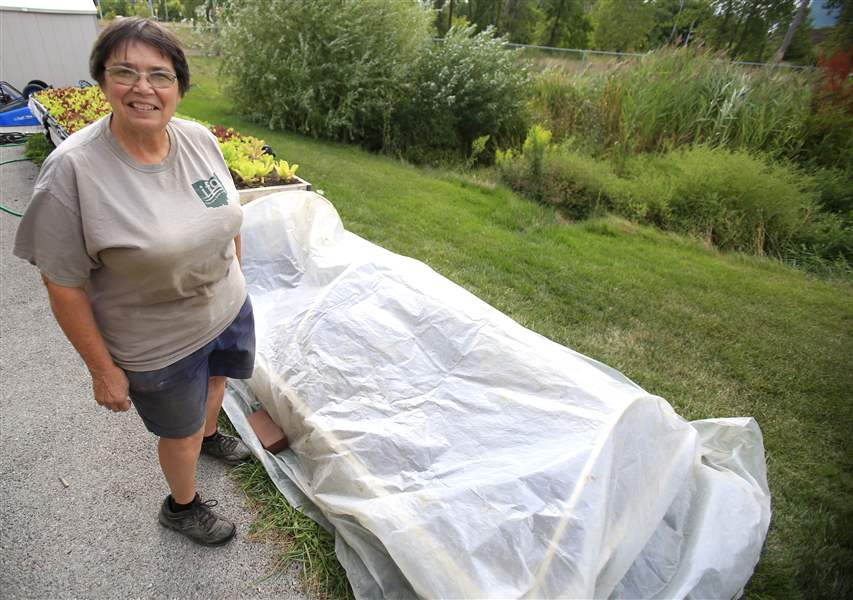
Cool crops: Simple covers can extend the season of fresh vegetables
9/5/2017
Sister Rita Wienken poses for a portrait with the covering at Toledo GROWS after demonstrating a method of keeping some crops protected during the winter months.
The Blade/Kurt Steiss
Buy This Image
The days are getting shorter and the nights are getting cooler. If only you could have one more bunch of carrots. A few more fresh greens.
You can, at least for a few more months, gardening experts say.
“I think a lot of people don’t take advantage of a fall crop as much as we should,” said Amy Stone, extension educator for the local OSU Extension Office.
With the right tools, which includes certain hardier cold-weather crops, gardeners can continue reaping what they have sowed after temperatures have dropped.
“The best things you can have out there are things like spinach, kale, swiss chard, carrots,” said Sister Rita Wienken, urban farmer with Toledo GROWS. “Once you start getting a light frost, you will need to protect them.”
Vegetables stop growing by about the end of October, so if they aren’t already in the ground, the turnaround at this point would be tight, said Sister Rita, who harvests certain crops all winter long in high tunnels or cold frames.
If you’re reading this and you live in Ohio, forget for another year the more fragile crops, such as tomatoes, peppers, and cucumbers. They won’t last, Ms. Stone said.
“I’ve had some people try to extend the season as it relates to warm crops, and might get away with a little later, but those tomatoes and peppers are intolerant and will turn black and wither,” she said.
Other vegetables that are happy to withstand cooler temperatures longer include cabbage, radishes, beets, winter greens, cauliflower, turnips, and other root crop. Think Thanksgiving.
OK, now we know which vegetables we can continue to enjoy just a little longer. But how?
Gardeners can buy or even build a cold frame or your own makeshift greenhouse fairly inexpensively, said Ken Lewandowski, an owner of Waldo and Associates and Premium Horticulture, a horticulture supply wholesaler.
Cold frames, tunnels, and other structures help shield vegetables from winds and hold in the necessary heat to allow them to continue growing.
“When that temperature mark drops below 50, that’s when you want to cover them to extend that season,” he said. “You can hold temperatures at night between 5 and 15 degrees higher by using [some type of cover].”
Another option is to make hoops out of PVC pipe and cover them with garden fabric, also known as row cover or floating row cover, to create a high tunnel, Sister Rita said. She and Ms. Stone also suggest a makeshift cold frame by creating a box around the vegetables from wood and using an old window at the top that can be opened during the warmer daylight hours for ventilation.
The soil in your garden can be used to hold down the edges of a tunnel, or mulch can be used as a natural heater over root crop beds, Sister Rita said.
For those who are less savvy at repurposing, most building supply stores have kits to assemble 8-by-10 foot, or 10-to-12 foot, homeowner greenhouses that are not restricted by city building codes, Mr. Lewandowski said.
The Internet, especially YouTube, is filled with how-to tutorials and videos on building cold frames and high tunnels. Some of them to check out include bit.ly/2gwfiP8, bit.ly/2ew6UOV, bit.ly/2iORsij, bit.ly/2wqyraC, bit.ly/2xDyPkB, bit.ly/2xDyPkB, or bit.ly/2wpZR0a.
Now is the time to also think about saving seeds from your plants and planting cover crops, Ms. Stone said. For more information, call the OSU Extension Office horticulture hot line at 419-578-6783. Master gardener volunteers staff the hotline from 10 a.m. to 1 p.m., Mondays, Wednesdays and Fridays.
Contact Roberta Gedert at rgedert@theblade.com, 419-724-6075, or on Twitter @RoGedert.